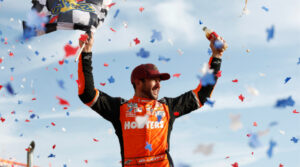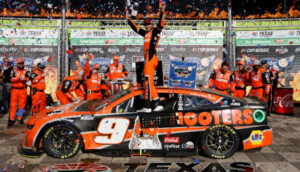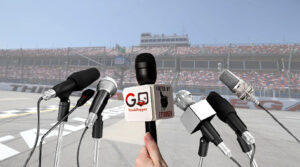A Bittersweet Reunion: The NASCAR All-Star Race at North Wilkesboro Speedway

A Triumph of Restoration and Promotion:
The grueling journey of restoring the North Wilkesboro Speedway stands as a testament to the dedication of NASCAR’s fans and officials. The once-abandoned track was brought back to life through sheer determination and an unwavering belief in preserving the sport’s heritage. Countless hours were spent refurbishing the weathered grandstands, patching up the aged asphalt, and ensuring the infrastructure met the safety standards of modern racing.
The hype and promotion leading up to the All-Star Race were unparalleled. NASCAR fans across the country were treated to a nostalgic flood of images, stories, and videos chronicling the golden days of racing at North Wilkesboro. The legends of the sport, including Richard Petty, Dale Earnhardt Jr., and Jeff Gordon, were not only present but played instrumental roles in building excitement for the event. Their shared memories and reverence for the track amplified the aura surrounding this hallowed ground.
The Preview:
Fans were treated to several special events in the days prior to the All-Star, including mid-week late model races, and a Saturday night concert, and bike enthusiasts joined Harley riders Clint Bowyer and Rusty Wallace for a lap around the track.
But then we moved on to the main focus—the Cup cars. And, in hindsight, Friday night’s lifeless practice session was an unfortunate preview of what was to come. Saturday night’s heat races were equally lackluster, with pole sitters Daniel Suarez and Chris Buescher each winning their respective heats, mainly because passing was almost non-existent on the one-groove track. However, inclement weather and the need for rain tires during the heats made it easy to excuse the lack of performance and caused all hopes to get pinned on Sunday’s race. And for a few shining moments during The Open, all the hype and all the hope seemed justified with a 3-way battle between Josh Berry, Ty Gibbs, and Aric Almirola as they eyed the top 2 spots to make the transfer to the main event. We also saw Michael McDowell and Ty Gibbs tangle a few times, the most entertaining of which came when McDowell sought payback and squeezed the 54 of Gibbs against the inside wall. Eventually, Berry and Gibbs would make the transfer, followed by Noah Gragson, who won the fan vote. And then it was time for the main event, kicked off by energetic driver introductions that had fans on their feet.
The Fall from Grace:
As the sun set over the historic North Wilkesboro Speedway, a palpable sense of anticipation filled the air. Months of meticulous work and an avalanche of hype had transformed this legendary track, once thought to be lost to time, into the epicenter of NASCAR’s All-Star festivities. Legends of the sport, past and present, graced the event, reigniting the spirits of fans who had longed to witness the old-school charm of racing at this revered venue. However, despite the grand preparations, the race itself fell painfully short of its lofty expectations, with only three lead changes between two drivers.
As the green flag dropped, the hopes of witnessing a throwback spectacle soared. However, it soon became apparent that the marriage between the iconic North Wilkesboro Speedway and the Next Gen car was less harmonious than predicted. The limitations of the car’s short-track package became glaringly evident, hindering the high-octane racing that fans craved.
Once Kyle Larson seized the lead, surprisingly as early as lap 18 after a penalty for speeding, he set sail with unmatched dominance, leaving the rest of the field in his rearview mirror. His supremacy was almost an embarrassment with a 12-second lead as he lapped half the field. Behind him, there were a few side-by-side battles and a random bump and run or two, but the heart-stopping maneuvers so often associated with short-track racing were conspicuously absent. The lack of significant on-track action or cautions further contributed to the race’s monotony. And the worn tires due to the old racing surface seemed to be a non-issue, despite how much commentators tried to make it one. As a matter of fact, after Larson won the million-dollar prize, he managed to put on a full-lap smoke show, and the tires still did not pop despite already withstanding 90 laps of racing, much of which was spent with the left sides on the rough concrete apron.
If NASCAR was truly seeking competition for this race, we question why they would have thrown a caution for a scheduled tire change at lap 101. It would have made more sense and created more suspense to have allowed the teams to decide their own strategy. It also would have made more sense for Goodyear to have brought a tire that wasn’t indestructible, considering the year-long narrative had highlighted the worn-out surface of the track and the need for tire strategy.
Despite praising Larson for his skill and dominance, even commentators realized it was a bad look for this race. At times, their comments almost willed something to happen to Larson’s tires, given how hard he was pushing. And Bowyer joked that he saw an engine block in the middle of the track, as he clearly hoped for a caution that would rerack the field. In the end, Chase Elliott’s post-race interview comments were the most telling when he described the race as “anti-climatic”. He was not wrong. It should have been obvious to NASCAR and fans that the old-school track was not going to produce old-school racing while using new school equipment and rules.
A Call for Improvement:
While disappointment looms over the All-Star Race, it’s crucial to remember that the setbacks were not due to a lack of effort or passion. NASCAR and its teams have made strides with the Next Gen car, yet it is evident that the short track package still needs a lot of work and potentially even more refinement for the unique demands of a track like North Wilkesboro.
As fans voice their discontent and many have branded the race a letdown, it is essential for NASCAR to learn from this experience. The alluring prospect of racing at iconic venues should not overshadow the need for an on-track product that captivates and excites fans. NASCAR should channel the passion that brought North Wilkesboro back to life into further improving on-track action because even the most storied tracks need synchronized harmony with modern racing technology.
By Rob White




